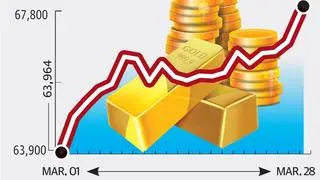With world steel demand continuing to lag supply, prices are expected to stay weak. Expanding steel production in China, the world’s largest producer and consumer of steel, even as domestic consumption tapers has been the single biggest drag on global prices.
In India, domestic steel manufacturers have managed to undertake some price hikes since September last year as they passed on the rise in raw material prices. This is, however, unlikely to continue, as rising steel imports, particularly from China, keep domestic prices under pressure.
Moreover, with the rupee now having stabilised, the protection from cheap imports provided by the weak rupee last year no longer remains. Following appreciation in the rupee, some domestic steel producers undertook price cuts in April to align their product prices with the landed cost of imports. Domestic steel prices (hot-rolled sheet) in China have fallen 16 per cent so far this year to $486 per tonne.
Supply to exceed demandEven as China’s crude steel production grew 2.6 per cent to 550 million tonnes (mt) for the year to August 2014, steel consumption contracted 0.3 per cent to 500 mt, during the same time. Steel production, on the other hand, continues to rise. China, which accounts for about 49 per cent of global steel production, contributed to 54 per cent of the increase in world production in 2014 (until August).
Elsewhere in the world too, the outlook for steel demand, which tracks overall economic growth, is far from bright. According to the IMF, while the global recovery continues, downside risks to economic growth in 2014 remain.
Leading economic indicators such as the Purchasing Managers’ Index indicate that the US economy is showing signs of improvement but the euro zone is still not out of the woods.
While the global steel demand-supply gap has narrowed since the slump created in the post-2008 period, production still exceeds demand. Global steel production, which is expected to rise to 1,644 mt (extrapolated) in 2014, will exceed demand, which is forecast to grow 3.1 per cent to 1,527 mt this year.
Impacted by the general economic slowdown and weak demand from key user industries — infrastructure, automobiles and consumer durables — India’s steel consumption grew only 0.6 per cent in 2013-14, the slowest in four years, to 74 mt.
Domestic pictureDuring the same time, domestic steel availability (production, minus exports, plus imports) rose 0.8 per cent to 85 mt. India, which has been a net importer of steel for several years, turned net exporter last year as domestic manufacturers tapped the overseas market, helped by the weak rupee. But with the rupee having stabilised since then and global steel prices continuing to stay weak, the threat of cheap imports into the country has increased.
India’s steel imports grew 23 per cent to 2.5 million tonnes in April-August 2014, compared to last year. The Indian economy showed some signs of a pick-up in the April-June quarter — GDP grew 5.7 per cent, the highest in 10 quarters, factory output expanded 3.5 per cent and the auto sector too reported high sales. But one has to wait and see whether the growth momentum will sustain — industrial growth contracted 0.5 per cent in July.
While the government’s thrust on infrastructure, housing and manufacturing, as reflected in measures introduced in the Budget and thereafter, will boost the demand for steel, the impact of this will be felt only over time. Domestic steel demand grew a meagre 0.3 per cent in the April-August period.
Meanwhile, rising imports are likely to keep domestic prices under pressure.








Comments
Comments have to be in English, and in full sentences. They cannot be abusive or personal. Please abide by our community guidelines for posting your comments.
We have migrated to a new commenting platform. If you are already a registered user of TheHindu Businessline and logged in, you may continue to engage with our articles. If you do not have an account please register and login to post comments. Users can access their older comments by logging into their accounts on Vuukle.